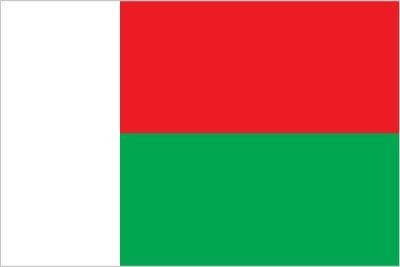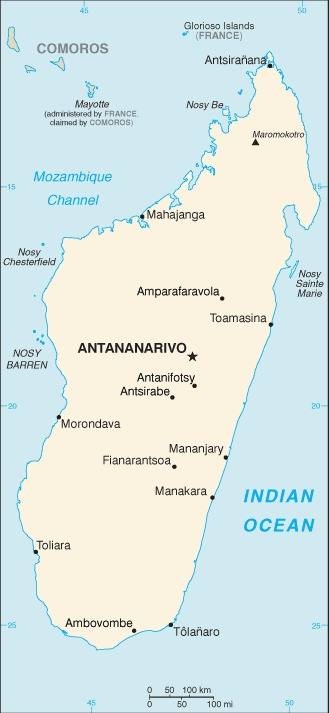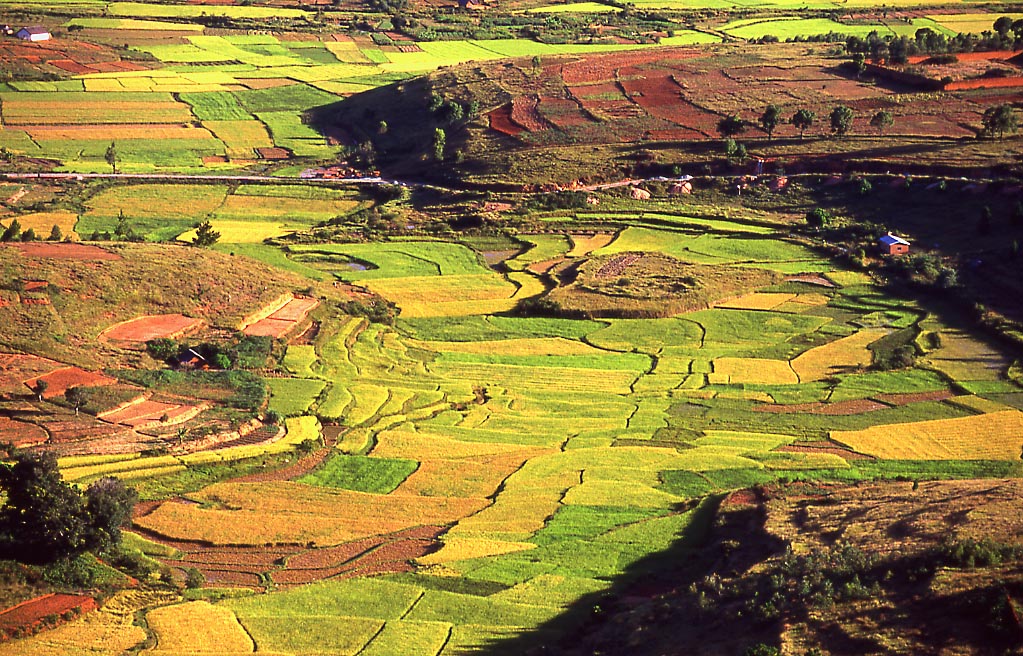206 Madagascar

Two equal horizontal bands of red (top) and green with a vertical white band of the same width on hoist side. By tradition, red stands for sovereignty, green for hope, white for purity.
Flag courtesy of the CIA World Factbook

Map courtesy of the CIA World Factbook

The terraced paddy fields of the central highlands of Madagascar (left) give way to tropical rainforest along the eastern coast (right)
Government
According to Britannica, the Malagasy Republic became independent in 1960, after a brief period as an autonomous republic in the French Community from 1958. Between 1972 and 1975 Madagascar was under military rule. Socialist political and economic reorganization was instituted in 1975, and a new constitution was implemented later that year for the renamed Democratic Republic of Madagascar. The public grew increasingly dissatisfied with the political and economic conditions of the country, and by the early 1990s the demand for change led to a gradual transition to democracy and a free market economy. In 1992 the country adopted a new name, the Republic of Madagascar, along with a new constitution that underwent subsequent revision. In 2009, following months of political unrest, a transitional regime came to power. A new constitution was passed by referendum in November 2010 and promulgated on December 11, 2010. The first democratically elected president under the 2010 constitution was inaugurated in January 2014.
Madagascar’s current constitution provides for a unitary republic with a president as the head of state and a prime minister as the head of government. The president is elected by popular vote to no more than two five-year terms. The president appoints the prime minister, who is presented by the majority party or coalition in the National Assembly. The legislative branch is bicameral and consists of the aforementioned National Assembly and the Senate. The members of the National Assembly are directly elected to five-year terms. The members of the Senate, one-third are presidential appointments, two-thirds are indirectly elected, also have five-year terms.
For administrative purposes, Madagascar is divided into a system of decentralized territorial collectivities: provinces, regions, and communes. The provinces, the largest units, are further divided into regions, which are subdivided into communes. Each province is administered by a directly elected head of the province and an elected provincial council. Regional administrations follow a similar structure, with a directly elected head of the region and an elected regional council. Communes, which are classified as either urban or rural, have directly elected administrations.
The former Merina state that ruled the island throughout the 19th century had an elaborate system of laws, courts, and justice. The present legal system, however, is based upon French codes and practices. There is a High Constitutional Court, a High Court of Justice, a Supreme Court, Courts of Appeal, and tribunals.
Madagascar Civil Aviation (MCA)
Madagascar Civil Aviation (MCA) was set up by Decree No. 2013-710 of September 17, 2013, stipulated in its article D1.2.2.-1. Their mission is to:
- Execute the State’s civil aviation policy.
- Develop, implement and monitor the application of civil aviation regulations in accordance with ICAO standards.
- Ensure compliance with and maintenance of safety and security standards and the efficiency and regularity of Air Transport, the promotion of civil aviation in Madagascar, healthy competition between operators and service providers, to the protection of the environment.
- Advise the Minister in charge of civil aviation on transport policy both at national and international level and to ensure its application.
Airspace
SkyVector – Google Maps – ADS-B Exchange
ICAO countries publish an Aeronautical Information Publication (AIP). This document is divided into three parts: General (GEN), En Route (ENR) and Aerodromes (AD). ENR 1.4 details the types of airspace classes they chose to adopt from classes A through G.
Drone Regulations
Piloting civil drones and aerial work
Advanced Air Mobility (AAM) Regulations & Policies
None found by the author.
However, should you, the reader, happen to stumble across something to the contrary, please email the author at FISHE5CA@erau.edu and you may be mentioned in the ACKNOWLEDGEMENTS section of this book by way of thanks for contributing to this free eBook!
Advanced Air Mobility (AAM) News
None found by the author.
However, should you, the reader, happen to stumble across something to the contrary, please email the author at FISHE5CA@erau.edu and you may be mentioned in the ACKNOWLEDGEMENTS section of this book by way of thanks for contributing to this free eBook!
Short Essay Questions
Scenario-Based Question
You have been hired by a Drone Startup Company. Your boss has immediately assigned this job to you.
They need you to prepare a one-page memo detailing the legalities of using a drone to survey the paddy fields in Madagascar, pictured above.
They need you to mention any national laws and local ordinances.
They specifically want to know what airspace (insert pictures) you will be operating in and whether or not you need an airspace authorization.
Does it matter whether or not you are a citizen of the country?
Lastly, there is a bonus for you if, as you scroll through this chapter, you find any typos or broken links!
Short Essay Questions
- What are the drone categories?
- How is registration addressed?
- How is remote ID addressed?
- What are the model aircraft rules?
- What are the commercial drone rules?
- Are there waivers or exemptions to the rules? If so, for what?
- Would you share a link to an interactive airspace map?
- How is BVLOS addressed?
- How can you fly drones at night?
- How can you fly drones over people?
- Where do you find drone NOTAMs?
- What are the rules for drone maintenance?
- What are the rules for an SMS program?
- What are some unique rules not mentioned above?
- What are the C-UAS rules?
- What are the AAM rules?

